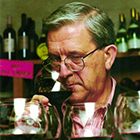by Cesare Pillon
Of the three elements that can make a wine great—that is, the vineyard, the vine and man—one alone is fixed, immutable so that it cannot be changed. It is the vineyard. If it is true that the variety and the grower are important, without a highly suitable vineyard it is impossible to make a great wine. What induced the French, who referred to the vineyard as the vignoble, to create another word, cru, to define it? Because not all vignobles are crus. And because cru, which literally means raw, coarse or crude, according to the French dictionary, has a second signification that applies not just to the vineyard. It is that portion of terrain where the cultivated products grow with the best characteristics.” Its most important prerogative is that of conferring on the product an unmistakable personality. There exists, therefore, an infallible method for verifying whether an agricultural terrain is really a cru. The product that emerges from these tests is totally identifiable, whether it’s the lentils of Castelluccio, the pistachios of Bronte or the saffron of Navelli. It is to the vine, however, that the concept of cru attaches most fully, so much so that the French, who were the first to understand the fundamental importance of terroir, methodically applied it to their most famous wine zones, not only in the Bordeaux area, where more than 150 years ago a hierarchy was established among them, but also in Burgundy and Champagne where zoning exists in fact through a rigid gradation of prices. The concept of cru is so deep and complex that the word is untranslatable. It has been accepted in the languages of all wine-producing countries, including Italy where, however, it becomes all too often and erroneously a synonym for premium wine. But it isn’t. Only if it is identified with the vineyard where it originated can it also be described as a cru. The confusion has historic roots in a time when industrialists and commerçants dominated the wine market. They acquired the grapes (or the wines) from vignaioli (growers) and saw to their distribution and sale. There was on their part a comprehensible reluctance to declare on the label the name of the vineyard from which the wine came, even if it was a privileged plot and would have justified a higher price. However, such a recognition would have placed in the hands of the proprietors of the best vineyards a bargaining tool they regarded as dangerous. This hidden opposition collapsed 40 years ago, swept away by a knockdown offensive by Luigi Veronelli with his journalistic interventions when wine was no longer perceived as a food but as a source of pleasure and when many growers, having understood the importance of cru, decided to vinify their own grapes and sell the wine. As often happens in Italy, this unleashed the opposite phenomenon, a race to invent excellent vineyards even where there were none. Opposition to the concept of the cru had not really collapsed. It now found its most enthusiastic supporters in the countries of the new enology. Not having a long history of winemaking behind them, they lacked the possibility of boasting about superb vineyards whose virtues had been confirmed by time. A counteroffensive was launched from those countries opposing the nobility of the territory with the quality of the variety and the geographical by the varietal appellation. Certainly, by calling Chardonnay or Cabernet Sauvignon wines, you can appeal to consumers throughout the world, secure in the knowledge that you will be immediately understood everywhere. The path of geographical denomination that culminates in the cru is more difficult and wearisome but it is also the route that guarantees the consumer a product of superior quality, since it is the territory that makes the difference, imprinting personality and character on the wine. The problem is to persuade the consumer to agree to the value of this difference. The complex conformation of the Italian peninsula has generated a multiplicity of territories highly suited to winemaking and profoundly different from one another. This environmental variety, multiplied by the possible synergies with a myriad of varieties that has no equal in the world, is able to generate an incredible number of wines with personalized and unmatchable characters, because of the creativity that distinguishes Italian producers. Paradoxically this enormous richness risks being seen as a handicap. How can the consumer, especially a foreigner, be oriented in such an intricate panorama? The response is found in this page: rigorously choose the crus that have demonstrated that they are truly such so that they can communicate to the world, all united in their own independence, the fascination of their diversity.



